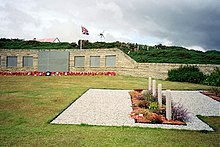Falklands War
[11] In 1977, the British prime minister, James Callaghan, in response to heightened tensions in the region and the Argentine occupation of Southern Thule, secretly sent a force of two frigates and a nuclear-powered submarine, HMS Dreadnought, to the South Atlantic, codenamed Operation Journeyman.[18][19] In December 1981, there was a further change in the Argentine military regime, bringing to office a new junta headed by General Leopoldo Galtieri (acting president), Air Brigadier Basilio Lami Dozo and Admiral Jorge Anaya.[21] By opting for military action, the Galtieri government hoped to mobilise the long-standing patriotic feelings of Argentines towards the islands, diverting public attention from the chronic economic problems and the ongoing human rights violations of its Dirty War,[22] bolstering the junta's dwindling legitimacy.[28] The invasion was met with a fierce but brief defence organised by the Falkland Islands' Governor Sir Rex Hunt, giving command to Major Mike Norman of the Royal Marines.[30] The invasion started with the landing of Lieutenant Commander Guillermo Sanchez-Sabarots' Amphibious Commandos Group, who attacked the empty Moody Brook barracks and then moved on Government House in Stanley.[35] The following day, during a crisis meeting headed by Prime Minister Margaret Thatcher, the First Sea Lord and Chief of the Naval Staff, Admiral Sir Henry Leach, advised that "Britain could and should send a task force if the islands are invaded".[40] This was the critical instrument of crisis management for the British with its remit being to "keep under review political and military developments relating to the South Atlantic, and to report as necessary to the Defence and Overseas Policy Committee".[40] On 31 March 1982, the Argentine ambassador to the UN, Eduardo Roca, began attempting to garner support against a British military build-up designed to thwart earlier UN resolutions calling for both countries to resolve the Falklands dispute through discussion.[43][44][45] The resolution stated: Deeply disturbed at reports of an invasion on 2 April 1982 by armed forces of Argentina; Determining that there exists a breach of the peace in the region of the Falkland Islands (Islas Malvinas), Demands an immediate cessation of hostilities; Demands an immediate withdrawal of all Argentine forces from the Falkland Islands (Islas Malvinas); Calls on the Governments of Argentina and the United Kingdom to seek a diplomatic solution to their differences and to respect fully the purposes and principles of the Charter of the United Nations.[69] Several of these flights were intercepted by Sea Harriers outside the British-imposed Total Exclusion Zone; the unarmed 707s were not attacked because diplomatic moves were still in progress and the UK had not yet decided to commit itself to armed force.[84] The first major Argentine strike force comprised 36 aircraft (A-4 Skyhawks, IAI Daggers, English Electric Canberras, and Mirage III escorts), and was sent on 1 May, in the belief that the British invasion was imminent or landings had already taken place.On one of these flights on 7 June, an Air Force Learjet 35A was shot down by HMS Exeter, killing the squadron commander, Vice Commodore Rodolfo de la Colina, the highest-ranking Argentine officer to die in the war.[99] Various options to attack the home base of the five Argentine Étendards at Río Grande were examined and discounted (Operation Mikado); subsequently five Royal Navy submarines were lined up, submerged, on the edge of Argentina's 12-nautical-mile (22 km; 14 mi) territorial limit to provide early warning of bombing raids on the British task force.[104] More successful was Operation Fingent, the placement of a Marconi S259 radar on high ground in Tierra del Fuego from where it could monitor movements at southern Argentinian air bases; the RAF crew wore civilian clothes in the guise of a sales team.A third group approaching from the south was led by the Second World War-vintage Argentine light cruiser ARA General Belgrano;[108] although old, her large guns and heavy armour made her a serious threat, and she was escorted by two modern Type 42 guided-missile destroyers, armed with Exocet missiles.Admiral Woodward was aware of the Argentine carrier group approaching from the other direction and ordered the cruiser to be attacked to avoid being caught in a pincer movement; he was unaware that the Veinticinco de Mayo had failed to gain enough headwind to launch her aircraft.[123] Given the threat to the British fleet posed by the Étendard-Exocet combination, plans were made to use C-130s to fly in SAS troops to attack the home base of the five Étendards at Río Grande, Tierra del Fuego.The operation was later scrapped, after acknowledging that its chances of success were limited, and replaced with a plan to use the submarine HMS Onyx to drop SBS marines several miles offshore at night for them to make their way to the coast aboard rubber inflatables and proceed to destroy Argentina's remaining Exocet stockpile - which did not exist at their objective.A Westland Sea King helicopter carrying the assigned team took off from HMS Invincible on the night of 17 May, but bad weather forced it to land 50 miles (80 km) from its target and the mission was aborted.[nb 2] The pilots would have been aware of this—but due to the high concentration required to avoid surface-to-air missiles, anti-Aircraft Artillery (AAA), and British Sea Harriers, many failed to climb to the necessary release point.[nb 3] In his autobiographical account of the Falklands War, Admiral Woodward blamed the BBC World Service for disclosing information that led the Argentines to change the retarding devices on the bombs.However, the disaster at Port Pleasant (although often known as Bluff Cove) would provide the world with some of the most sobering images of the war as ITV News video showed helicopters hovering in thick smoke to winch survivors from the burning landing ships.[168] During this battle, 14 were killed when HMS Glamorgan, straying too close to shore while returning from the gun line, was struck by an improvised trailer-based Exocet MM38 launcher taken from the destroyer ARA Seguí by Argentine Navy technicians.The Prime Minister, Robert Muldoon, was in London when the war broke out[179] and in an opinion piece published in The Times he said: "The military rulers of Argentina must not be appeased … New Zealand will back Britain all the way."[180][182] Encouraged by the generous response of New Zealand, the Australian prime minister, Malcolm Fraser, was rushed into offering to cancel the intended purchase of HMS Invincible, which was quickly accepted by the British.[184] Four Exocet missiles that had been ordered by Peru were prevented by the French government from being delivered by air and, after pressure from Britain who suspected that they would be passed on to Argentina, delayed their release to a Peruvian ship until the conflict was over.This brief war brought many consequences for all the parties involved, besides the considerable casualty rate and large materiel loss, especially of shipping and aircraft, relative to the deployed military strengths of the opposing sides.The islanders had full British citizenship restored in 1983; their quality of life improved through investments made by the UK after the war and by economic liberalisation that had been stalled for fear of angering Argentina.[258] However, a study of British combat veterans conducted five years after the conflict found that half of the sample group had suffered some symptoms of post-traumatic stress disorder (PTSD), while 22% were assessed to have the complete syndrome.[261] In 1986, the BBC broadcast the Horizon programme In the Wake of HMS Sheffield, which discussed lessons learned from the conflict, and measures taken to implement them, such as incorporating greater stealth capabilities and providing better close-in weapon systems for the fleet.
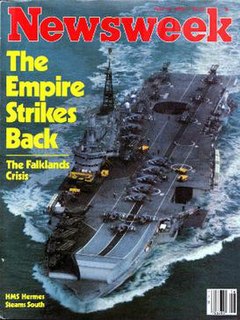























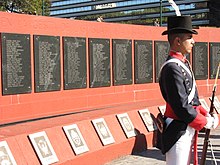


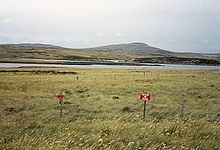
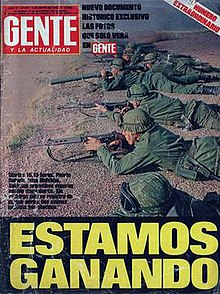
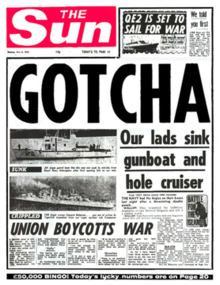
Falkland Crisis of 1770Battle of the Falkland IslandsFalkland Islands sovereignty disputeHMS HermesHMS BroadswordHMS AntelopeSuper ÉtendardsArgentine forces at Port Stanley, 2 April 1982Falkland IslandsSouth Georgia and the South Sandwich IslandsUnited KingdomArgentinaMargaret ThatcherTerence LewinHenry LeachJohn FieldhouseSandy WoodwardJeremy MooreMichael ClappJulian ThompsonTony WilsonLeopoldo GaltieriJorge AnayaBasilio Lami DozoJuan LombardoErnesto Horacio CrespoMario MenéndezType 42Type 21landing shipcontainer shipcruisersubmarinenaval trawlerCOIN aircraftOperation RosarioSouth GeorgiaOccupationOperation CorporateParaquetBlack BuckSanta FeBelgranoSobralSheffieldPebble IslandMikadoSuttonSan CarlosArdentSeal CoveAntelopeAtlantic ConveyorCoventryGoose GreenMount KentTop Malo HouseBluff CoveMany Branch PointMount HarrietTwo SistersGlamorganSir GalahadMount LongdonCortley RidgeWireless RidgeMount TumbledownPort StanleyThule & South Sandwich Islandsundeclared warBritish dependent territoriesSouth Atlanticits territorial dependencyArgentina invadedoccupied the Falkland Islandsinvasion of South Georgianaval task forceArgentine NavyAir Forceamphibious assaultsurrenderFalkland Islandersprotracted disputesovereigntyCrown colonyfavour British sovereigntydeclared warbooks, articles, films, and songsruling military governmentdemocratisation of the countryConservativewas re-elected with an increased majority the following yearDiplomatic relations between the United Kingdom and ArgentinaMadridconstitutionself-governingBritish Overseas TerritoryEvents leading to the Falklands WarUnited NationsForeign and Commonwealth OfficeparliamentaryJames Callaghanfrigatesnuclear-powered submarineHMS DreadnoughtOperation JourneymanMinister of State for Foreign AffairsNicholas RidleyleasebackLondonArgentine juntaJorge Rafael VidelaRoberto Eduardo ViolaNational Reorganisation Processmilitary juntadiverting public attentionDirty WarLa PrensaArgentine MarinesArgentine flagSouth Georgia IslandHMS Enduranceinvasion of the Falkland IslandsNicholas BarkerJohn Nott1981 Defence White Paper


